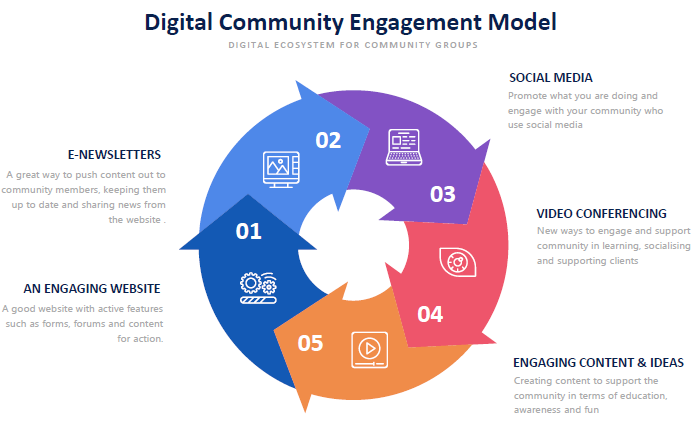10 tips for communicating with an online community
We were pleased to welcome Kate Doodson, Joint Chief Executive of Cosmic, to speak at our recent event all about how to set up and manage an online community.
Online communities are a great way to connect with people, especially during lockdown. But it’s important to make sure communities are inclusive and accessible. Watch the event in full using the link below to find out more.
Ten tips for using digital communication and tools
During the event, Kate explained that Cosmic is passionate about supporting digital inclusion for older and more vulnerable people, including the 7% who are totally offline. We’ve written this news post with a summary of Kate’s top ten tips about how to use digital communication and tools for your online community group:
1. Create a website: A website gives you the space to represent your brand, giving your audience somewhere to go for information and contact details. Try to focus on sharing information in a simple, clear and informative way. You can create simple websites easily using website builders like Wix, Weebly and Squarespace.
2. Send a regular E-newsletter: Digital newsletters are a valuable way to share information, with around 1 in 4 people likely to open your newsletter. Sending newsletters regularly is key. You can use templates provided by platforms like MailChimp and it’s good to include around four key bits of content.
3. Connect through social media: Social media can help you to connect with people in meaningful ways, especially if you listen to their needs. Different channels are popular with different age groups, Kate recommends using the channels that work best for you and your audience. You can also engage through existing forums and local groups (Facebooknearyou).
Kate Doodson, Cosmic, shared this community engagement model which suggests using websites, e-newsletters, social media, video calls and content.
4. Use video calls: While Facebook Messenger and WhatsApp are great for small group calls, for larger meetings and events try using platforms like Zoom, Teams or Google Meet. These platforms also have accessibility settings and offer settings to ‘hide self-view’. Try interacting with your audience in creative ways using tools like Jamboard, Slido or Kahoot.
5. Create new content: Tools like Canva help you to create images, reports and e-books. You can also create simple videos using Zoom recordings or use Microsoft’s screen capture to record yourself perming a digital task like ‘how to upload a form’. Don’t forget to research how to make your content accessible for all your users.
6. Send forms and invitations: If you already have Google or Office you will have access to free tools to create forms and invites. You can use Typeform which has excellent templates that can integrate with your website and take payments.
7. Use registration pages for events: You can set up a registration page for your event using platforms like Eventbrite, which also helps you to promote your event to a wider audience. Platforms like Calendly are also simple to use.
Here’s an example of the registration page we created using Eventbrite for our recent event
8. Set up an intranet behind the scenes: An intranet is like an internal website. You can platforms like Google sites or Microsoft SharePoint to build an internal area where you can share information, a calendar, and useful files like logos.
9. Create impressive reports quickly and easily: Microsoft Sway is a tool for creating interactive reports with text, videos, images and Excel. Copy your content from PowerPoint into Sway and it builds the report for you.
10. Build a Database: CRM stands for ‘Customer relationship management’. You can use a CRM instead of a spreadsheet to securely record details about your clients. Hubspot, Capsule and Zoho all have free options available.
We hope you found this news post helpful! Don’t forget you can also watch the full event for more tips on digital communication and tools for online communities.
Read more about how Cosmic can help you with digital communication, and find out how Smartline is working with enterprises to improve digital products and services.


